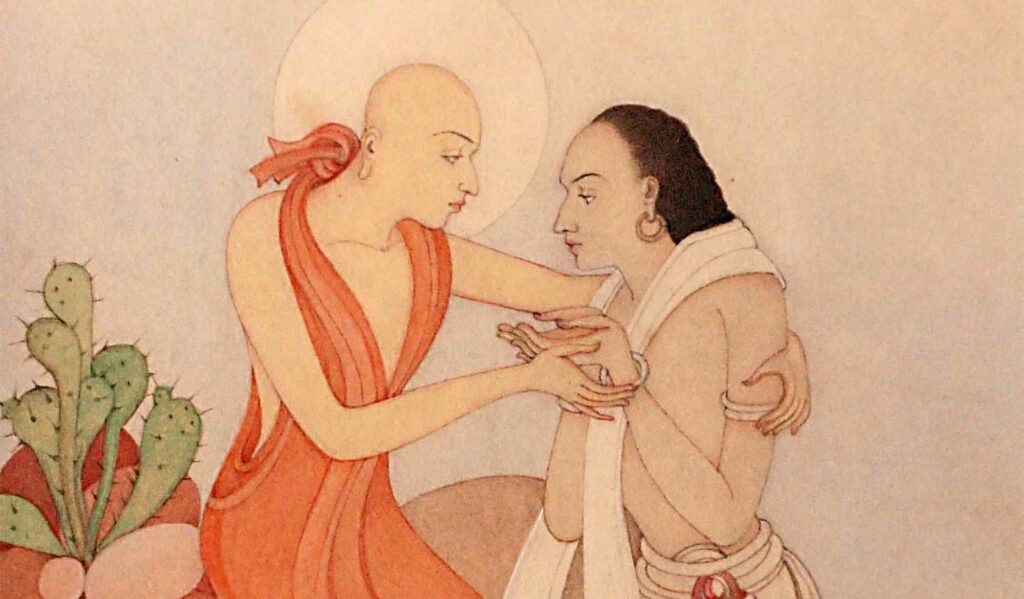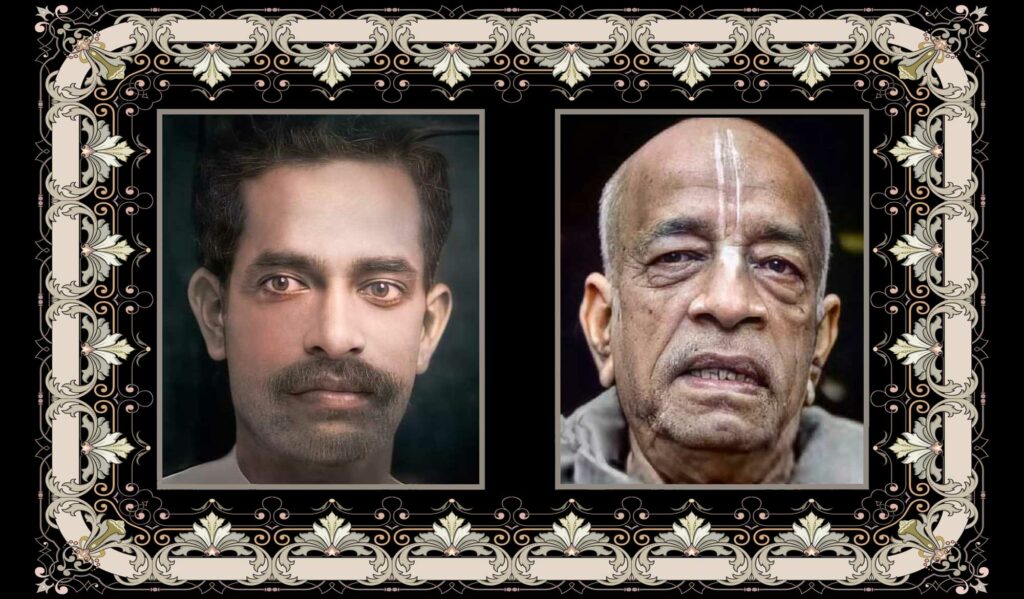Overview
Are all kīrtanas the same or are there gradations? In "Kīrtana is Not Simply Music!" Mañjarī Devī Dāsī, a professional musician, explores this point and explains the emotional impact that mundane music has on us, as compared to the transcendental nature of the Holy Name.
Sound. It’s a vibration, and if the ear can detect such a vibration, then we perceive it. Sound is also subtle and affects us in many ways beyond the everyday sounds that we hear. For example, ‘sound-weapons’ are used by the U.S. military to control their opponents. There’s even been examples of sound-weapons being used by the U.S. military at Area 51 to keep the curious from attempting to enter certain restricted areas. There they are met with a pulsing vibration that is unbearable.
From a scientific perspective, take the experiment conducted by Dr. Emoto. In his experiments, he analysed the formation of crystals shaped differently as it was exposed to different sounds in different forms. He focused on verbal affirmations of peace, love, and gratitude as they were being directed to the water in a Petri dish. He then analysed the water under a microscope and documented before and after. He observed beautifully formed crystals formed in the water where positive vibrational waves were directed. When exposed to the music of Mozart, Beethoven and other classical composers, beautiful crystals also formed. He also experimented with negative affirmations like ‘I will kill you,’ and found malformed and incomplete crystals manifested. His conclusion was that any sound is a vibration, and vibrations can make or mar someone’s mood, energy, etc. In this regard we should consider that the human body is made up of 65% water. Thus, what we put into our ears can positively transform us, or cause great destruction.
Being a trained classical singer, I have sung some of the acknowledged greatest works of all time, including standard works such as Mozart’s ‘Requiem’, Hayden’s ‘The Creation’, Bach’s ‘St. Matthew Passion’, as well as countless operas, chamber, and choral music. I sang music from all over the world – French, German, Italian, Russian, and even African languages. Additionally, I sang works by avant-garde composers such as Schoenberg and John Cage. I had a fondness and distinct ear for music that I still hold to this day. I am certainly grateful as different music led me to question consciousness and my relationship with God, through singing pieces about divinity from mystics and poets all over the world.
There is something peculiar about musical sounds. They have such an affect over us, emotionally hitting us in different ways depending upon the structure of the music. For example, music set in a major key usually creates a happy emotion, whereas music in a minor key is more sorrowful and usually denotes death, lost love, or other types of painful situations. While the voice is the most powerful and moving element, instrumental works alone also cause these waves of emotion. In one given symphony there will be an upbeat movement followed by a slower movement. The voice however moves us in such a way since no material instrument is as powerful as the human voice. My music teacher used to tell me that the difficult part about teaching someone how to sing is that every human body is different, and you cannot see inside at the vocal folds without an external device. It is therefore a highly subtle mechanism that is working within the body. Therefore, the voice is the ‘uttering mechanism’ that produces syllables and words – another element of sound.
Yet something happens after listening to, and performing music over time.
We get bored!
Even after listening to your favourite song hundreds of times, try putting it on repeat while being stuck in a room for 24 hours straight. You’re guaranteed to go crazy, and you’ll beg for it to be turned off. No material sound of this world can produce anything transcendental. It is, in fact, temporal. As my Guru Mahārāja, Śrīla B.G. Narasiṅgha Mahārāja says:
“The mahā-mantra is quite different. It is an absolute sound which puts us directly in touch with Kṛṣṇa. So it’s not a song of this world. It’s a transcendental vibration. So a materialist cannot sustain an interest in enjoyment. However long the enjoyment they become frustrated with it soon afterwards.”
No matter how beautifully a song is sung, or perfectly played by the most expert of instrumentalists, the song will inevitably be tossed aside and a new one will be rehearsed, taken up, and performed. Otherwise, why is there so much repertoire and so many genres of music?
The beautiful thing about the human voice is that it is a part of this body, and who does the body belong to? Kṛṣṇa. Thus we have a special opportunity to chant and vibrate the Holy Name of the Lord with this tongue and utilise external instruments such as the mṛdaṅga and karatāla to accompany the chanting of the mahā-mantra.
Anyone in the West who practices Kṛṣṇa Consciousness, or chants the mahā-mantra, is inevitably indebted to the personality who brought it to the West – Śrīla A.C. Bhaktivedānta Swami Prabhupāda. During the time of Śrīla Prabhupāda, mṛdaṅga and karatālas were the only instruments used during the ārati and only a few melodies were sung. It was never the practice in the Gauḍīya Maṭha to utilise the harmonium. Actually, the harmonium is a German instrument, but it was adopted in India, and almost every sahajiyā group uses it – thus, Sarasvatī Ṭhākura was not in favour of using it. Our Śrīla Prabhupāda continued that practice in the west, and although he did play the harmonium, he did not encourage the devotees to play it in the temple. The only exception was preaching outside because the sweet sound of the instrument attracted the public.
Sound creates an emotional response in us and the lyrical and chromatic response of the harmonium can produce a false sentimental feeling for a realm that is far beyond our mundane understanding, as well as beyond our present position. In short, the harmonium simply becomes a representation of mundane emotions. There is nothing transcendental about it. As Śrīla B.G. Narasiṅgha Mahārāja says:
“It’s the vehicle for the whimpering. When you run across it and it sends goosebumps on your skin, you’ll know exactly what I’m talking about. It’s much worse than a slimy rickshaw-wallah touching you. It’s much worse than that – that sound crawls to your soul.”
My Guru Mahārāja recollected that once, during the Gaura Pūrṇimā festival in Māyāpura, the devotees held a ‘hari-nāma competition’ where both devotees and local Bengalis competed. When Śrīla Prabhupāda heard the sound from his room, he called for his personal servant, Hari Śauri Prabhu, who inquired, “Prabhupāda, what is wrong?”
Prabhupada replied, “What is that sound? Find out what is that sound?”
“It’s a hari-nāma competition,” remarked Hari Śauri.
Prabhupāda replied, “Hari-nāma competition? It is hari-nāma aparādha!” Suffice to say, the hari-nāma competition was stopped.
What we learn from this anecdote is that without following the standards of proper kīrtana then we will deviate. It is not something that can be changed according to time, place, and circumstance, because the Holy Name and hari-nāma saṅkīrtana is our main practice as outlined by Śrī Caitanya Mahāprabhu. We must first cultivate a conception of the Holy Name, then carefully chant while focusing on the Name.
We find so many buzz-words in the world of kīrtana such as ‘bliss,’ ‘ecstasy’ etc. but actual bliss and ecstasy are not so cheap and so easily attained. We are dealing with the highest conception of Divinity and our goal is to serve the Name – not demand a sensation for the body and mind in order to serve such feelings. Pūjala rāga-patha gaurava-bhaṅge – we must keep the highest plane of Divinity above our head and remain a little distant and below. There are nice moments in kīrtana, especially when chanted by a proper agent and we should be content with that. All these other feelings are like the above-mentioned water analogy – they are just working on a cellular level within the body and mind and are nothing but our mundane connection with ‘music’ pertaining to how professional and perfect the voice and instruments may sound, and how they vibrate in the body and mind. When we hear people say, ‘I like the vibe,’ or ‘I don’t like the vibe’ then they are identifying with the likes and dislikes connected with bodily and mental responses. So many people attend a kīrtana and claim to ‘like the vibe,’ but many times they are connecting that kīrtana with music that they have experienced in the past.
Nowadays we find so many additional western instruments used in kīrtana – guitars, drum sets, flutes, violins, djimbe etc. as well as different genres of music to accompany the mahā-mantra.
But in fact, the musical aspect is unimportant. It is the Holy Name that is all-important. When we mix mundane music with kīrtana, then we are lost because they have nothing in common. The reaction to mundane music is found in the mental systems response to such music – it makes me feel happy, it makes me feel sad, it sounds good, it sounds bad etc. It is all associated with the fleeting moments and emotions contained within the mind.
In regards to using so many musical instruments in kīrtana, Śrīla Prabhupāda found it unnecessary and considered it to be a distraction:
“My opinion is that it is not necessary for us to utilise these different musical talents for spreading Kṛṣṇa Consciousness. I would rather see people follow strictly the path of Lord Caitanya and His saṅkīrtana devotees. We are using mṛdaṅga, karatāla, that is enough. We are not musicians. We are kṛṣṇa–bhaktas. Therefore we do not stress so much importance on these different musical talents. Śrī Caitanya Mahāprabhu is God Himself. Had He thought it would have been better to spread Kṛṣṇa Consciousness by another way He would have done so. But no, simply with mṛdaṅga and karatāla, traveling and chanting Hare Kṛṣṇa, asking everyone to chant Hare Kṛṣṇa, preaching simply Śrīmad Bhāgavatam philosophy, this is the process. There is no need for us to try and add anything to this simple method. It will only be a distraction. Therefore I request you to follow the simple path of Lord Caitanya Mahāprabhu and help me spread this wonderful mission all over the world.” (Letter to Jagadiśa Paṇḍita Dāsa, Bombay 28th December, 1974)
The best kīrtana doesn’t have to be materially perfect. If the devotee leading the kīrtana holds a proper conception of the Holy Name then that is what is flowing through. This is paramount. Yet we find many places where sub-par kīrtana groups chant, but know little to nothing about what they are chanting, and in some cases, may not even follow any regulative principles. Considering how Śrīla Prabhupāda stopped the so-called hari-nāma competition, it’s not hard to think what our previous ācāryas would have to say about such a clown-show!
“Vaiṣṇavas are advised not to join an assembly of chanters that comprises a majority of nāmāparādhīs, and if the lead singer is a nāmāparādhī. However, in a kīrtana group consisting mainly of śuddha-bhaktas and bhaktas upon the platform of nāmābhāsa, there is all good reason to participate. And such participation will bring great satisfaction and spiritual bliss.” (Śrīla Bhaktivinoda Ṭhākura, Jaiva Dharma)
“We must hear from the pure devotee. Pure devotion! Not from the unconscious section. Maybe the musical sound is very nice, but it will not purify the heart. That sound must be uttered in proper connection, properly following all the rules and regulations. Not simply with a good voice and cinema-style music. So, it is better to have one drop of pure nectar. That is better than drinking an ocean of sweet rice with sand inside.” Śrīla B.G. Narasiṅgha Mahārāja, Vṛndāvana, 1994)
All of this culminates in the importance of sound. We must hear proper kīrtana that is beneficial for our spiritual life from a qualified person situated in the paramparā. This presupposes that we must eliminate sounds which deviate us, that simply make us ‘feel good,’ or ‘kīrtana’ which may sound like the real thing, but isn’t. Such sounds is a vehicle for carrying a philosophical misconception which leads us astray and pollutes the conception of the Holy Name. Thus, if we carefully follow the process for kīrtana as given by our ācāryas, we will be protected from so many persons who claim to know what is kīrtana and bhakti–yoga, but who are nothing but charlatans.
Prema Dhāma Deva Stotram with the Narasiṅgha Sevaka Commentary – Verses 61-65
In verses 61 to 65 of 'Prema Dhāma Deva Stotram', Śrīla Śrīdhara Mahārāja narrates the pastime of Śrī Caitanya at Caṭaka Parvata In Purī and explains how the scriptures produced by Brahmā and Śiva are ultimately searching for the personality of Mahāprabhu who is merciful too all jīvas, no matter what their social position.
Prabhupāda Śrīla Sarasvatī Ṭhākura’s Visit to Ayodhyā
With the forthcoming observance of Śrī Rāma Navamī, we present 'Prabhupāda Śrīla Sarasvatī Ṭhākura’s Visit to Ayodhyā' written by Śrīla Bhaktisiddhānta Sarasvatī Ṭhākura Prabhupāda from The Gaudīyā magazine, Vol 3. Issue 21/ In December 1924, after visiting Benares and Prāyāga, Sarasvatī Ṭhākura visited the birth-site of Śrī Rāmācandra in Ayodhyā.
Śaraṇāgati – The Only Path to Auspiciousness
In this article, 'Śaraṇāgati - The Only Path to Auspiciousness', Dhīra Lalitā Dāsī analyses the process of śaraṇāgati (surrender) beginning with śraddhā (faith). She also discusses the role of śāstra and the Vaiṣṇava in connection with surrender.
Ātma Samīkṣā – The Value of Introspection
In this article, "Ātma Samīkṣā – The Value of Introspection" Kalki Dāsa highlights the importance of introspection in the life of a devotee and especially in relation to the worldly environment that surrounds us. He also explains how transcendental sound influences our capacity to introspect.
Prema Dhāma Deva Stotram with the Narasiṅgha Sevaka Commentary – Verses 61-65
In verses 61 to 65 of 'Prema Dhāma Deva Stotram', Śrīla Śrīdhara Mahārāja narrates the pastime of Śrī Caitanya at Caṭaka Parvata In Purī and explains how the scriptures produced by Brahmā and Śiva are ultimately searching for the personality of Mahāprabhu who is merciful too all jīvas, no matter what their social position.
Prabhupāda Śrīla Sarasvatī Ṭhākura’s Visit to Ayodhyā
With the forthcoming observance of Śrī Rāma Navamī, we present 'Prabhupāda Śrīla Sarasvatī Ṭhākura’s Visit to Ayodhyā' written by Śrīla Bhaktisiddhānta Sarasvatī Ṭhākura Prabhupāda from The Gaudīyā magazine, Vol 3. Issue 21/ In December 1924, after visiting Benares and Prāyāga, Sarasvatī Ṭhākura visited the birth-site of Śrī Rāmācandra in Ayodhyā.
Śaraṇāgati – The Only Path to Auspiciousness
In this article, 'Śaraṇāgati - The Only Path to Auspiciousness', Dhīra Lalitā Dāsī analyses the process of śaraṇāgati (surrender) beginning with śraddhā (faith). She also discusses the role of śāstra and the Vaiṣṇava in connection with surrender.
Ātma Samīkṣā – The Value of Introspection
In this article, "Ātma Samīkṣā – The Value of Introspection" Kalki Dāsa highlights the importance of introspection in the life of a devotee and especially in relation to the worldly environment that surrounds us. He also explains how transcendental sound influences our capacity to introspect.








